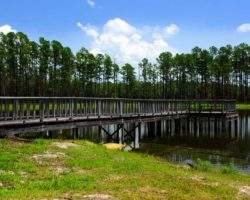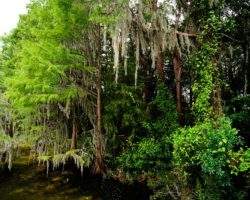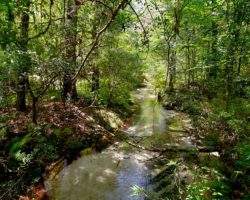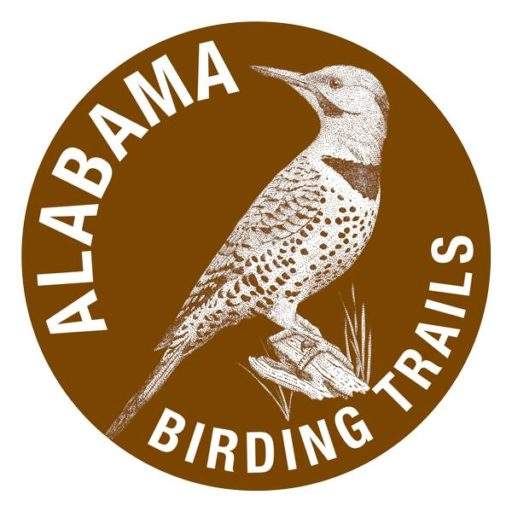Wiregrass | Covington | Best Seasons: Fall | Spring | Winter
Frank Jackson State Park is a 2,050-acre park centered on 1,000-acre Lake Frank Jackson, and offers boating, fishing, swimming, hiking, camping, and picnicking. There are also a number of nature trails and boardwalks through stands of mature hardwoods, providing access to islands and marshy areas which hold substantial promise as for birding.
Immediately after passing the entrance gate and bearing left (right fork for campers only), look to the right (south) for an open agricultural area. In the warmer months, there are Indigo Buntings, Field Sparrows, and Blue Grosbeaks. In the colder months, there are multiple winter sparrows, and Northern Harriers are possible. To the left (north) is a mixed-hardwood woodlot that provides good sightlines and easy access to a variety of species, primarily woodpeckers, Eastern Towhees, Indigo Buntings, nuthatches, and the like.
One of the park’s several hiking trails begins at the kiosk to the right. This slightly elevated path is more or less open, skirting middle-age hardwoods to the right and the park road to the left. In less than a mile, a short marked nature trail departs from the road’s edge. This is a short loop and presents mostly resident songbirds.
The park road continues until it forms a loop as it reaches the lake. The trees around the edges of the road, the parking lot, and the picnic areas are good places to look for migrants. Walk to the lake’s edge and scan the water and surrounding trees for Ospreys, Bald Eagles, Anhingas, and in the colder months for waterfowl and gulls.
Take the boardwalk over to Memorial Island. This island is bisected by another walking trail and is the least-visited portion of the park. This relatively undisturbed area is a good place to look for songbirds. The shoreline is the park’s best location to see herons and egrets.
If you return to US 331 and proceed north, the highway cuts across the park, dividing the lake into two parts. The boating/fishing/swimming lake lies to the left (southwest), while to the right (northeast) lies a very large swamp with snags of trees and lily pads. During spring and early summer, there is a large heron rookery on the far shoreline. Unfortunately, there is no access to this portion of the park by road. If the traffic flow allows, park by the side of US 331 and use a spotting scope to scan the swamp. This effort may be rewarded with breeding Prothonotary Warblers, Anhingas, Purple Gallinules, Common Moorhens, King Rails, and Least Bitterns. You can also turn left (northwest) from US 331 onto CR 38, pull onto the side of the county road, and scan the smaller swamp to the right (northeast) for Purple Gallinules, Common Moorhens, rails, and Least Bitterns. The park is open year-round with a nominal entrance fee.
GPS: 31.3425733 -86.2539519
Frank Jackson State Park
100 Jerry Adams Drive
Opp, AL 36467
(334) 493-6988
From the intersection of US 84 and US 331 in Opp (Covington County, all visitor services available), proceed north on US 331 (Main Street) for .7 mile, turning left (west) on West Jeffcoat Avenue. Jeffcoat becomes Opine Road in .2 mile. The well-marked entrance to Frank Jackson Park is .9 mile ahead on the right (north).
Amenities Available:
Nearby Sites

Conecuh National Forest
The 83,000 acres of the Conecuh National Forest house scores of Red-cockaded Woodpecker colonies and hundreds of Bachman’s Sparrows in the pine forests. You’ll find breeding Anhingas, Purple Gallinules, Common Moorhens, King Rails, and Least Bitterns …

Florala City Wetland Park
The twin sites along the shores of 500-acre Lake Jackson provide boardwalk access through and above cypress hammocks, palmetto and scrub woods, and dense tangles of wetland and swamp plants. This is a superb site for wetland-loving songbirds, and a r …

Solon Dixon Forestry Education Center
The Solon Dixon Forestry Education Center in the Conecuh National Forest is operated by Auburn University and hosts classes and conducts research projects throughout the year. The 5,300-acre tract offers a tremendous diversity of plants, many of whic …
